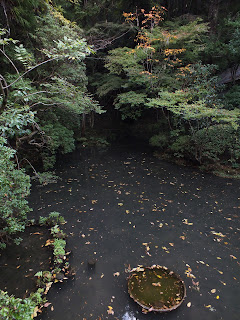It's not a stretch to say that Kyoto is the heart of
Zen. Or at least, it's been the heart of Zen as we know it since the
Higashiyama Period, the 15th-century golden age of Japanese Zen culture. The period is named after the mountains on the eastern flank of Kyoto, which is not coincidentally Kyoto's busiest tourist district.
Zen infused everything in old Higashiyama, from gardening and architecture to
arranging flowers and
drinking tea. And the epicenter of this Zen renaissance was
Ginkaku-ji, the Temple of the Silver Pavilion, then a mountainside villa for a retired shogun, now a ten-minute walk from the little B&B where we stayed.
The pavilion itself looks out on
the classic Zen garden - a great place for quiet contemplation.
 |
| And for getting photo-bombed by nattily-dressed Japanese men. |
The front part of the temple garden is in what I very unprofessionally think of as the "severe Zen" style: precisely manicured rock gardens with painstakingly sculpted sand.
 |
| This is actually a video. He's just being really Zen. |
Further back, though, the rock gardensgive way to a labyrinth of dim, wooded walks.
 |
| The momiji (Japanese maple) were in full flame. |
 |
| I always find yakusugi (Japanese cedar) delightfully spooky. |
As you can see, the Japanese have an eye for seamless blends of artifice and nature: a mossy forest floor picked completely clean of fallen leaves, a glassy koi pond with islands and inlets and coves, a sturdy whitewashed temple framed with timbers worn nearly black with age.
At times, it's like the aesthetic spilled out of the temples and into Higashiyama itself. Take, for example, these glimpses of the famous
Philosopher's Walk, a meandering hillside walk that connects northern Higashiyama's most important sites.
 |
| This is what philosophy looks like. |
The Philosopher's Walk is crowded with beautiful little temples that would get top billing anywhere else. Seeing them all would take at least a day and cost a small fortune (those little entrance and upkeep fees really start to add up).
One, for instance, had an ancient-looking traditional gate.
 |
| Thatched. |
Inside were more meticulous sand sculptures.
 |
| Plus the obligatory bridge over the obligatory pond. |
Seriously, every little turn seemed to bring some breathtaking little thing.
Through the course of our travels, I took literally hundreds of these snapshots, trying to capture some tiny fraction of all the pretty things.
 |
| Somehow I ended up in a few of them. |
For those of you keeping score at home, that's three temples down, of at least a solid half-dozen where we really spent some time. Stay tuned for Eikan-do and Nanzen-ji, the two heavy hitters at the southern end of the Philosopher's Walk.






































Definitely looks like a Fachwerkhaus! ;)
ReplyDeleteGreets from a german reader,
Mari